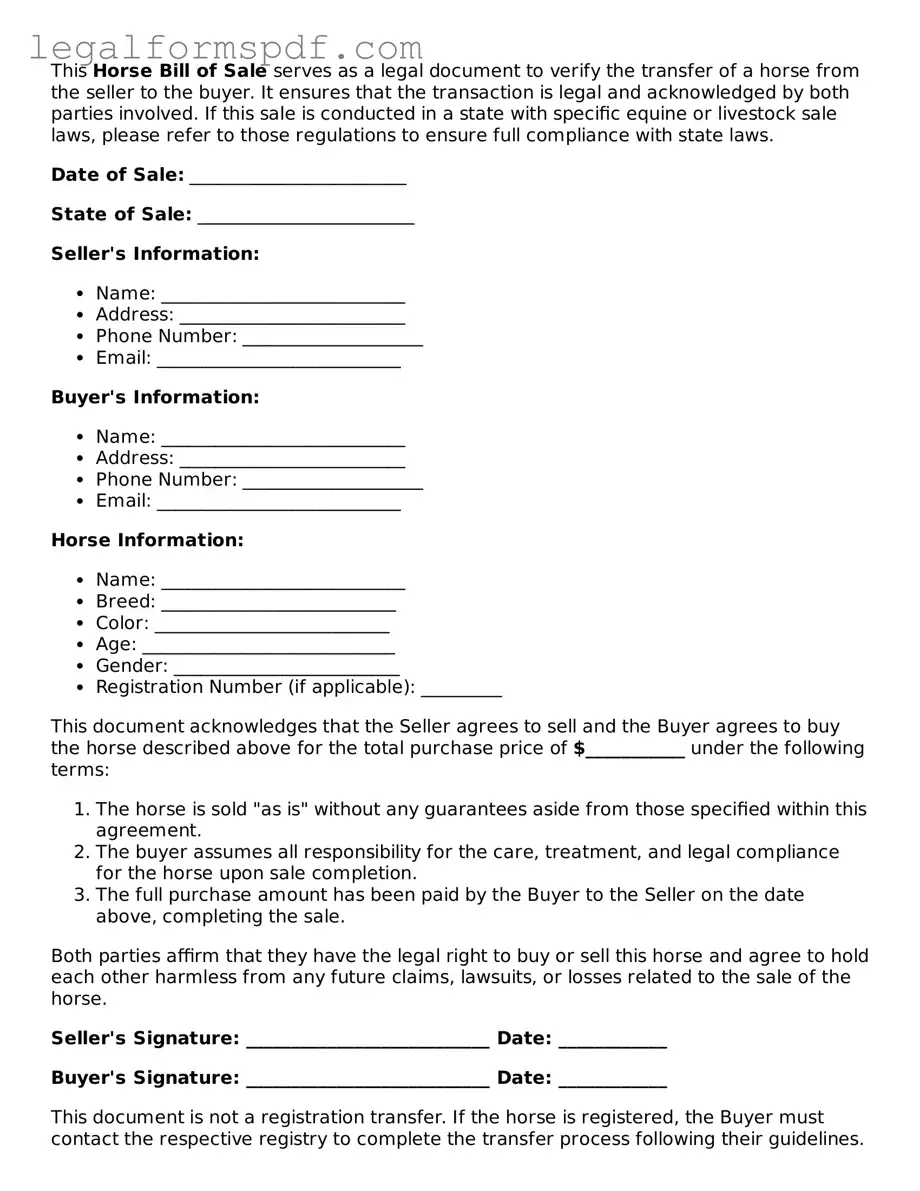The Horse Bill of Sale is quite similar to a Car Bill of Sale, as both documents are essential for legally transferring ownership of personal property from one party to another. Each document records the sale details, including the identification of the item sold (be it a horse or a car), the sale price, and the date of sale. Both forms act as a receipt for the transaction and serve to protect both buyer and seller by documenting the terms agreed upon at the time of sale.
Similarly, the Boat Bill of Sale mirrors the purpose and structure of the Horse Bill of Sale. It's used to document the transfer of ownership of a boat. This document captures specifics such as the boat's make, model, year, and serial number, alongside the sale price and the parties' information. Both documents are pivotal in registering the item with appropriate authorities and may be required for tax reporting purposes.
Another parallel can be drawn with the Firearms Bill of Sale. This document similarly functions to legitimize the change in ownership of a firearm from seller to buyer. It includes detailed descriptions of the firearm, the identities of the transacting parties, the sale price, and terms. Both the Firearms and Horse Bill of Sale are crucial for ensuring compliance with respective state laws and for personal records.
Equipment Bill of Sale shares resemblances with the Horse Bill of Sale too, as it is used when selling or buying equipment. Both documents detail the specifics of the item being sold, including a description, the condition of the item, the sale price, and the parties' details. They play a significant role in the legal transfer of ownership and serve as a proof of purchase.
The General Bill of Sale is another document with a broad application, including the sale of horses, which underscores its similarity to a Horse Bill of Sale. It's a more flexible document that can cover a wide range of items beyond animals or vehicles, but it still captures essential details such as the item sold, the identities of the buyer and seller, and the transaction terms.
In the realm of property transactions, the Real Estate Bill of Sale stands out. While it's primarily used for the transfer of ownership of real estate, elements of its structure echo those of the Horse Bill of Sale, including the necessity for clear description of the property being transferred, identification of the parties involved, and the terms of sale. Both documents are pivotal in their respective fields for the finalization and recording of sales.
The Business Bill of Sale is akin to the Horse Bill of Sale when a business changes hands. This document outlines the specifics of the business being sold, such as assets and inventory, similarly capturing the agreed-upon price and terms between the parties. These documents help in ensuring a smooth transition of ownership and serve as a legal record of the sale.
Likewise, the Aircraft Bill of Sale shares similarities, used when an aircraft is bought or sold. It comprises details like the aircraft's make, model, and serial number, the sale price, and the parties' information, resembling the Horse Bill of Sale in its function to legally document the transaction and change of ownership.
Pet Bill of Sale is also akin to the Horse Bill of Sale. It's specifically tailored for the sale of pets, detailing the breed, date of birth, and health information of the pet, alongside transaction specifics. Both documents are essential for documenting the transition of care and ownership, highlighting responsibilities and agreements made at the sale.
Lastly, the Artwork Bill of Sale is related, serving artists and collectors in transactions involving artwork. Like the Horse Bill of Sale, it includes a description of the piece, the identity of the buyer and seller, the sale price, and terms of the transaction. This documentation is crucial for establishing provenance, ownership, and value of the artwork over time.
